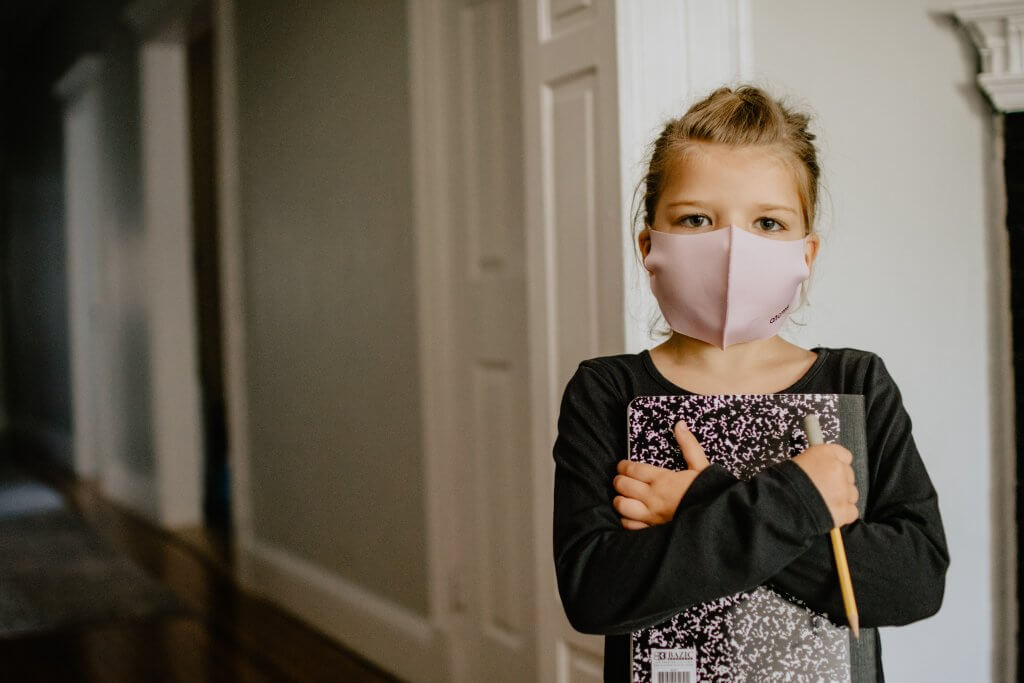Although the use of masks has continued to save lives throughout the coronavirus pandemic, there is one thing that most didn’t expect to come from prolonged mask-wearing: acne. Dubbed “maskne,” this form of acne and face irritation is caused by the skin’s reaction to being covered by a mask or face shield for an extended period of time. Though this type of acne is usually reserved for athletes along their helmet lines, the increased use of masks has left many reaching for solutions from their youth.
Recent health guidelines indicate that masks are crucial to slowing the spread of COVID-19 and many areas of the country have mandated that people wear face coverings while interacting with others outside of their home. Masks have become an important, required part of daily life and will continue to be for the foreseeable future.
Which leaves the question – what can we do about maskne?
Dr. Alanna Bree, M.D., is a pediatric dermatologist at A Children’s House and a clinical professor of dermatology at Baylor College of Medicine and Texas Children’s Hospital. She is also a member of the Society of Pediatric Dermatology.
Bree shares tips on combatting maskne during the winter months.
Information and tips on how to combat maskne
Is maskne different from other types of acne? How so?
Maskne is similar to other forms of acne in many ways, but the cause is unique as it arises specifically from or is exacerbated by wearing a face mask. Maskne is caused by the same factors as typical facial acne and blemishes — pore blockages and oil build-up — yet is localized and worsened by skin irritation from face mask friction and increased humidity underneath the material of the face mask.
Read: Mask mandate leads veteran to pivot her lipstick business
What are the main factors contributing to the occurrence of maskne?
Maskne occurs when the hair follicles on the face become irritated, inflamed, and clogged. The material of the face mask also offers the perfect environment for saliva, sweat, and oil to be trapped close to the face, naturally adding to irritation and breakouts. Additionally, the increased heat and friction against the skin creates small cracks and micro-fissures in the protective skin barrier that permits bacteria to enter and cause breakouts.
What are some ways in which individuals can combat/treat the effects of maskne? Any general product/routines they should be aware of?
The best way to combat the effects of maskne is to cleanse your face and mask daily, moisturize to protect the skin barrier, and find a mask with the right fit and material. Daily cleansing is vital to remove daily oil and dirt while moisturization is crucial to protect the skin barrier and decrease the likelihood of maskne breakouts from irritation. Especially after cleansing, moisturize with a thick, non-comedogenic cream — not a thinner lotion that may contain irritating ingredients for sensitive skin.
Does the type of mask you wear make a difference?
The fit and material of each face mask is an underestimated factor in maskne breakouts. The mask should fit snugly around the mouth and nose — not too large as to allow movement around the face and not too tight. The proper fit will decrease chafing, lessen irritation, and discourage touching and readjusting that could put you or your family at risk. A mask made of natural materials, like cotton or antimicrobial fabric, can be less irritating than synthetic fabric.
How often should a person clean a reusable mask — and what type of cleansers are best?
Washing the face mask daily or as often as possible is vital to removing sweat, oil and bacteria growth in the mask material that can be transferred onto the face. This is also important as a damp or reused mask can be less effective in protecting against the spread of the virus. A normal laundry detergent or soap with hot water is sufficient for washing the mask by hand or in a washing machine.
How often should a person clean their face? What types of products work best for frequent cleansing?
It’s important for all ages to cleanse their skin daily, ideally once in the morning and once at night, with a mild cleanser to remove built-up dirt, oil, and bacteria on the skin that can contribute to breakouts throughout the day. For children, avoid soap-based cleansers or any products with alcohols, dyes, or fragrances that are marketed toward adults as they can be too harsh on sensitive skin.
Will changes in season bring about different challenges/issues? What are some recommendations to help combat those issues should they arise?
The winter can exacerbate dry skin issues as the harsh transition from the cold air outside to the hot, central heating inside is tough on the natural skin barrier. Additionally, as the area inside the mask is warmer and can become moist, daily gentle cleansing is important. Moisturization following cleansing is key to combat dryness and irritated skin, and taking a mask break in a safe space every three to four hours can help let the skin breathe.
At what point in time should a person seek out professional medical help?
As with all forms of acne, a person should seek professional medical help if the condition worsens or does not go away on its own. For children, if the condition is affecting you or your child’s quality of life, reach out to your local, board certified dermatologist or pediatric dermatologist to determine a proper treatment plan.
Is there any other information you think is important to know?
While maskne can be a frustrating issue due to wearing a mask, it is so important to wear one regularly, not only to protect yourself but also others from the spread of this potentially deadly virus. Fortunately, maskne can easily be addressed with a simple skincare regimen and proper cleaning of your mask. So please mask up to save lives and hopefully, these tips will help you love the skin you’re in.
Read comments







































